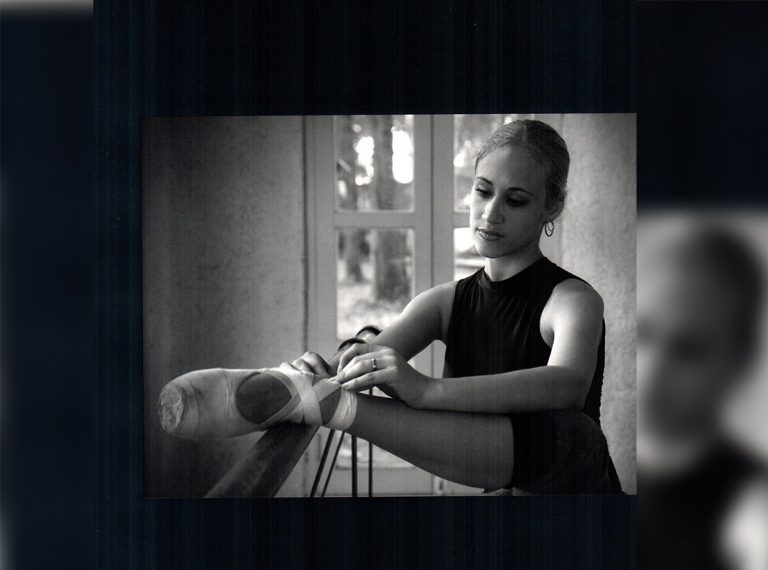If you have not visited the Workers Square recently, I invite you to enjoy a suggestive photographic exhibition that adorns the site: Matria. It is not a surprise that Gabriel Dávalos has selected this city to pay tribute to the prima ballerina assoluta Alicia Alonso.
The creator gives a harmonic connection between emblematic places of the city and young dancers from Camagüey who extract poetic movements from a calm city. Similar purposes had the snapshots of Alfredo Cannatello, who captured with his lens the members of the company in rehearsals, breaks and classes, both photographic samples are genuine images of the Camagüey ballet that can compete with Degas’s paintings.
Looks of amazement, gestures of admiration and smiles of complacency are the applause that passersby give to a sui generis performance of the Camagüey ballet.
Genesis
The company has its origins in 1936, with the first Ballet School founded by Gilda Zaldívar Feyre. Her commitment to children allowed her to forge one of the essential traditions within the cultural sphere, a year later the staging of Sleeping Beauty and The Nutcracker became memorable performances at the Main Theater.
In 1952, her work was continued by Martha Matamoros Cordero, from the Alicia Alonso Ballet, creating the academic institution that became a branch of the Alicia Alonso Ballet School. The dancers’ performances denoted rigor in their preparation and choreographic skill. A little night music, with music by Mozart, it is probably the first original choreography performed in the province.
It is the responsibility of Vicentina de la Torre Recio, former student of -Gilda Zaldívar-, to maintain the education of classical dance. She maintains the same goals as her teacher for Camagüey and founded her school in 1957. She trained with Fernando Alonso and since 1961 she directed the Municipal Academy of Ballet, later turned into a Provincial School of Art and integrated into the national artistic education system.
Her work is unfolded in the artistic preparation of her pupils, the creation of a professional company and the selection of her best students from a group to exercise the “teaching career”, not yet instituted in the country.
Today some of the graduates of that class remain in the classrooms of the Provincial Art School that bears her name, who continue spreading wisdom within the pedagogy of dance.
Camagüey Ballet on stage
The debut of the Camagüey Ballet took place at the Main Theater on December 1st, 1967, since the success of Les Sylphides, the Pas de Trois of the first act of Swan Lake and La Fille Mal Gardèe, the work of the company has spread, they have a repertoire with more than 250 works of classical, romantic and contemporary styles, with presentations in Spain, New York, Mexico, Japan, Greece, the People’s Republic of China, Brazil, among other countries.
Luxury guide
The contribution of the Cuban National Ballet (BNC, by its acronym in Spanish) was important for the initial stage; human, pedagogical, technical and material resources were accompanied by the commitment and dedication of Fernando and Alicia.
Frequently established figures of dance pedagogy and excellent performers such as Josefina Méndez, Mirtha Plá, Loipa Arújo, Aurora Bosch, Lázaro Carreño and others shared the stage with the novel group and promoted the dance project, later dancers and directors of other latitudes such as Elena Vinográdova, from the Kirov Theater ballet, Jorge Lefebre, artistic director of the Royal Ballet of Walloni, Belgium, Asaf Messerer, Peter Breuer, Pedro Ruiz, among others.
The management of Joaquín Banegas, Fernando Alonso, Jorge Rodríguez Vede and its current dean Regina Balaguer have left a distinctive mark on the company, which enjoys great international prestige, consolidates its artistic work between renewal, audacity, youth and the improvement of academic technique. Its successes have been innumerable with emblematic works such as Saerpil, Les Sylphides, Coopélia, Don Quixote, Sensemaya, among others. Choreographers, màitres, régisseur, essayers, designers and anonymous faces share the achievements of the company.
It is worth noting the constant presence of Maestro Fernando Alonso, exceptional guide of the group that influenced its international reach. Since 1976 the company has been the headquarters of the International Ballet Festival of Havana and for the tenth anniversary of its creation the prima ballerina assoluta Alicia Alonso together with Jorge Esquivel performed the pas de deux of the second act of Swan Lake.
A worthy exponent of the Cuban School of Ballet, the Company lavishes skill and virtuosity, shares knowledge in sociocultural projects, ballet classes and the night school, an art that takes root in a city that always dances with its ballet company.
Translated by: Aileen Álvarez García






